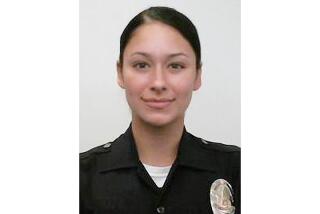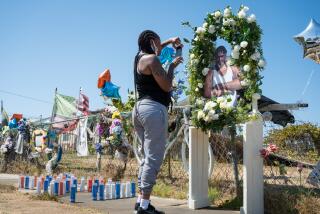1978 San Diego cop-killing case an early test of state’s new parole law
reporting from san diego — Even the convicted killer now admits it was brutal and senseless: a young police officer left in the gutter, three bullets in his chest, one in his right temple, after a traffic stop.
The San Diego Police Department was shaken by the slaying of officer Archie Buggs that damp night in late 1978. In its aftermath, officers demanded better equipment and an end to the policy of having one-officer cars even in high-crime areas.
The civic leadership had yet to fully accept that San Diego had a growing menace of street gangs and drug violence. But denial was no longer possible after the murder of Buggs, 30, an Army veteran of Vietnam, an African American pledged to helping the community where he grew up.
Now the pain of the Buggs case has resurfaced.
Unless Gov. Jerry Brown intervenes, Buggs’ killer, convicted of first-degree murder and given a life sentence, is set for parole. The case should arrive on Brown’s desk in late July and he will have 30 days to decide what to do.
The case is an early test of a new state law meant to make parole easier to attain for inmates given lengthy sentences for crimes committed before they were 18.
Jesus Cecena, with a long list of juvenile crimes, was four months shy of 18 on Nov. 4, 1978, when Buggs stopped him for speeding. The officer discovered an open can of beer in the car and put it on the car’s roof.
Cecena stood outside the car as Buggs began to write a ticket. His passenger, a fellow gang member, handed Cecena a gun and he began firing, including a final shot to make sure Buggs was dead. Buggs had fired back but missed.
Cecena then sped off, leaving Buggs with his service revolver in his hand, the engine of his patrol car running and his ticket book in the street.
Now 53, Cecena has been recommended by a parole board panel for release under SB 260, which became law Jan. 1. It requires the board to give “great weight to the diminished culpability of juveniles” and also to consider an inmate’s “maturity and rehabilitation in prison.”
At a hearing in April at Valley State Prison in Chowchilla, where he is an inmate, Cecena testified that he has had a “spiritual reawakening,” has renounced violence and is deeply remorseful for the Buggs slaying, for which he takes “full responsibility.”
Since 1985, Cecena has had a dozen parole hearings. At some, he claimed he fired at Buggs only in self-defense.
After early involvement with a prison gang, his record for the last two decades has been clean. He’s helped mentor younger inmates and participated in programs such as Alcoholics Anonymous and Criminals and Gang Members Anonymous.
He married in 2008 and has had several offers of jobs and places to live if he’s ever released. He would prefer to be paroled to Fresno to be near his wife in Madera, although parole to San Diego County, where his brother has offered him a job, is a possibility.
Cecena told the parole board he thinks of Buggs every day, prays for his family and wants to “honor Officer Buggs in a positive way” by living a peaceful, productive life.
“It is for the murder of Officer Buggs, the heartache, pain, grief, loss and senselessness of my actions, that I am sorry and indescribably remorseful,” he said. “I know that saying I’m sorry will never be enough and has no true meaning unless I show it through my character and how I conduct myself and how I treat and relate to others.”
San Diego Dist. Atty. Bonnie Dumanis, Police Chief Shelley Zimmerman, the San Diego Police Officers Assn. and numerous retired officers who served with Buggs have appealed to Brown to keep Cecena in prison. Before the issue reaches the governor, the police officers association hopes to rally politicians and police organizations statewide.
“This was a cold-blooded execution of an on-duty police officer, which devastated the officer’s family, his department and our community,” Dumanis wrote to Brown this month.
Cecena, Dumanis warned the governor, “is still a ruthless ‘cop killer’ who was wrongly granted parole. Cecena poses an unreasonable risk of harm to society if released.”
Evidence at trial indicated that Cecena fired five times, then paused, walked toward the fallen officer and, standing over him, pumped a final bullet into his head.
In his testimony to the parole board, Cecena mentioned firing repeatedly in “a panic” but stopped short of explaining the final bullet fired point-blank. Dumanis, in her letter to Brown, argues that Cecena’s refusal to admit the circumstances of the final shot shows that he has not accepted full responsibility for his actions.
Deputy Dist. Atty. Richard Sachs told parole board members that Cecena sounded like a convict tailoring his supposed admission to what they wanted to hear.
Blood splatters on Cecena’s clothing proved he was standing over Buggs when he fired the last shot, Sachs said. Cecena’s assertion that he approached Buggs to “check on the welfare of the officer and that’s how he got blood on himself … is preposterous,” Sachs said.
At his 1979 trial, Cecena declined to testify and then refused to talk to a probation officer doing a pre-sentencing analysis, according to news accounts at the time. At his previous parole hearings, he did not take sufficient responsibility for the killing to satisfy parole board members, according to a transcript of the April hearing.
Buggs had stopped a car driven by Cecena at 1 a.m. for a traffic violation in the Skyline area.
Cecena and his passenger, Jose Arteaga, who was 20, had been drinking beer and smoking marijuana laced with PCP. Within hours of the killing, they were arrested by SWAT officers without incident at the home of Cecena’s girlfriend.
Buggs’ death led to a dispute between officers and the police chief over issues of officer safety, particularly the department’s preference for single-officer patrol cars. The department later started employing two-officer cars more frequently, though not in all instances.
In the years after Buggs was killed, the department began issuing bullet-resistant vests, shotguns and better communications gear. Buggs had purchased his own vest, but it lacked side panels; three of the shots struck him in the right side.
Jerry Sanders, who was a patrol officer in 1978 and later became chief and then mayor, said Buggs’ killing was one of several violent incidents in that era that led to a “loss of innocence” in San Diego.
“San Diego had always been a safe city,” said Sanders, now chief executive of the Chamber of Commerce. The Buggs killing, he added, “was a sobering event for everybody. For officers, it heightened their awareness that they are mortal.”
Arteaga also was sentenced to life in prison and may eventually be eligible for parole.
Tracy Lum, the attorney who represented Cecena at the April hearing, noted in an email to The Times that the board found he “truly meets all suitability factors listed for consideration’’ for parole. The board member on the panel, she added, was someone with a law enforcement background: Arthur Anderson, a former top official of the California Highway Patrol.
“Nobody denies this crime was horrible,” Lum said, but “the law is the law.”
At the end of the hearing, Walter Johnsen, part of the parole panel, said Cecena is eligible for parole because he “does not pose an unreasonable risk of danger to society or a threat to public safety.”
SB 260, sponsored by Sen. Loni Hancock (D-Oakland), was supported by a number of psychologists, clergy, prisoners rights groups and Human Rights Watch. The California District Attorneys Assn. and the California Police Chiefs Assn. opposed it.
In 2012, Brown signed a bill allowing for under-age offenders sentenced to more than 25 years in prison to seek a reduction in their sentences. In 2013, SB 260 came amid increased pressure on the state to reduce prison overcrowding.
According to state figures, about 5,700 inmates are serving sentences for crimes they committed as juveniles. Of those, 333 have served more than 25 years. Through the end of May, 108 parole hearings have been held under provisions of SB 260.
Most of the officers who served with Buggs are retired and carry painful memories about the slaying. Buggs, who was unmarried, had been with the department for four years, earning commendations.
David Jebb was the first officer on the scene, responding to a “shots fired” call before anyone knew that the victim was a police officer. “He was still warm,” Jebb said in an interview. “The blood was still oozing from him.”
Days earlier Jebb had urged Buggs to be careful during traffic stops. Buggs was known for making multiple traffic stops, looking for stolen cars.
“He was young, energetic and wanted to save the world,” Jebb said. “He became a cop for the right reasons, to help people. He wasn’t one of those who was badge-heavy or liked to push people around.”
Roberta Flynn had been patrolling a nearby neighborhood. She and Buggs were friends. “In those days some people were not thrilled at having women and African Americans on the department, so we kept a low profile,” she said.
Flynn was busy making an arrest on her beat when Buggs stopped Cecena’s car. If she had been free, Flynn wonders if Buggs might have called her for backup.
A few years ago Flynn wrote about the killing for a writing class she was taking. When it came time to read her story to the class, she broke down and could not continue.
“I will never forget the horror of that night,” Flynn wrote in her letter urging the governor to reject the parole. “To this day, I still miss Archie Buggs.”
Times staff writer Paige St. John in Sacramento contributed to this report.
More to Read
Sign up for Essential California
The most important California stories and recommendations in your inbox every morning.
You may occasionally receive promotional content from the Los Angeles Times.










